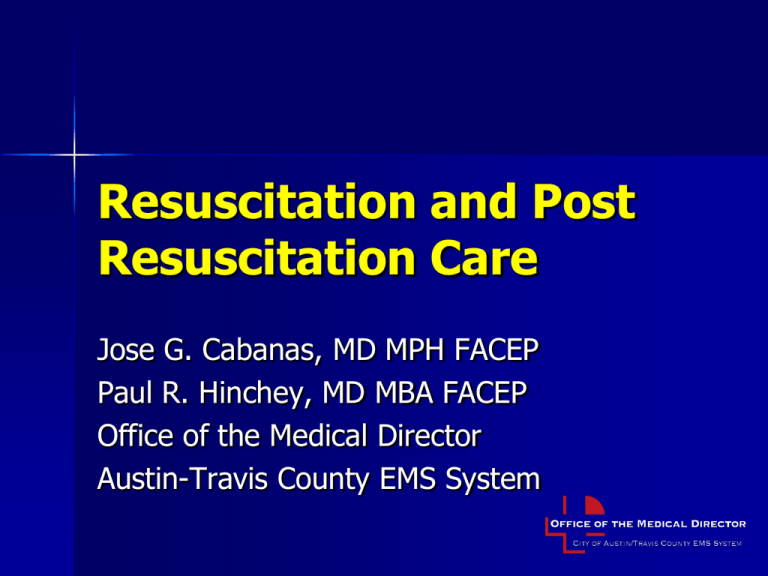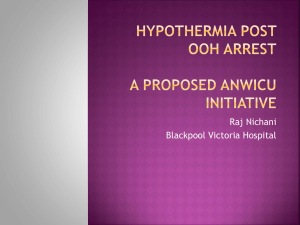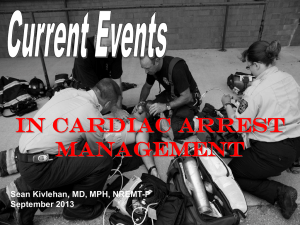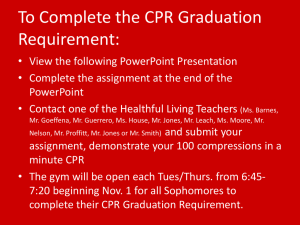
Resuscitation and Post
Resuscitation Care
Jose G. Cabanas, MD MPH FACEP
Paul R. Hinchey, MD MBA FACEP
Office of the Medical Director
Austin-Travis County EMS System
Austin/Travis County EMS
Approximately 1.2 million citizens, 1,100
square miles, 120k EMS calls per year
1,000 cardiac arrests responses per year
14 Fire Departments (1,500 FF’s,)
EMS Transport Agency (400 Paramedics)
EMS Systems are judged by their cardiac
arrest resuscitation rates
–
–
–
–
Most large cities are 5-7%
King Cnty Wa 35-45%
Wake Cnty NC 38-42%
Austin 38%
Why are we talking
about Cardiac Arrest
Resuscitation?
Philosophy of Five
Time Dependent
– Acute MI (STEMI)
– Acute Stroke
– Trauma / Surgical Emergency
Intervention Dependent
– Cardiac Arrest
– Respiratory Distress
Sophisticated providers/systems understand
the difference
Time Dependent
These conditions can not be definitively
treated in the pre-hospital environment
Requires specialized intervention only
available in the hospital
Outcomes are improved by early access to
definitive intervention
Goal is recognition and short scene
interval
Intervention Dependent
Initial treatment can be delivered in
prehospital environment
Outcomes linked to prehospital
interventions
Goal is identification and initiation
of treatment
Scene intervals are NOT critical
Updates in Out-ofHospital Resuscitation
and Post Resuscitation
Care
Objectives
Describe the importance of continuous
compressions and controlled ventilations
Discuss what to do with the airway/drugs
Acknowledge the difficulty of performing continuous
compressions and the need for a scripted process
Discuss importance of on-scene post ROSC
stabilization
Describe role of resuscitation centers
Identify questions for the future
Why do we worry about CA
Represents < 1% of our calls but…
> 70% of CA arrests occur outside the
hospital
Definitive management of cardiac arrest is
in the prehospital environment
“Stated succinctly, if ACLS care in
the field cannot resuscitate the
victim, ED care will not resuscitate
the victim.”2005 American Heart Association Guidelines for
Cardiopulmonary Resuscitation and Emergency
Cardiovascular Care (Part 7.2: Management of
Cardiac Arrest)
Priorities in OOHCA Changed
Emphasis on compression
Limit interruptions from ANYTHING
Goal is to maximize % of time in
compressions
Single D-fib every two minutes
– Precharge monitor before break
– Follow d-fib immediately by compressions
Decreased importance of ventilations
– Fewer number of breaths
– Each delivered more slowly
So if you had to
push a car,
would you push
a few feet and
stop….. only to
start again a few
minutes later?
So how important are
compressions?
Compression fraction article
Circulation 2009
If compressions are the most
important therapy when do
you move the patient…..
Prehospital Emergency Care 2011;15(1):106
Results (Pre-Feedback)
N = 108
% (25th, 75th)
Scene Correct Rate%
Median: 44.8 (9.54, 59.6)
Mean: 38.49 CI (33.2, 43.78)
Transport Correct Rate%
Median: 11.16 (5.83, 39.32)
Mean: 23.16 CI (18.35, 27.97)
Scene Correct Depth%
Median: 40.94 (15.96, 73.29)
Mean: 45.06 CI (38.76, 51.37)
Transport Correct Depth%
Median: 8.88 (2.62, 49.01)
Mean: 26.37 CI (20.12, 32.63)
Results (Post-Feedback)
N = 35
% (25th, 75th)
Scene Correct Rate%
Median: 48.16 (14.68, 62.36)
Mean: 43.6 CI (34.61, 52.59)
Transport Correct Rate%
Median: 19.0 (9.52, 60.22)
Mean: 32.78 CI (23.21, 42.33)
Scene Correct Depth%
Median: 75.73 (36.23, 95.07)
Mean: 66.86 CI (56.57, 77.16)
Transport Correct Depth%
Median: 14.0 (4.78, 90.78)
Mean: 42.04 CI (27.98, 56.11)
How about ventilations?
Importance of controlled
Ventilation
Normal inspiration is negative pressure
– Encourages blood return to the chest
Artificial ventilation is positive pressure
– Reduces blood return to the chest
The faster the ventilation rate the higher the
mean intrathoracic pressure
Higher MIP reduces cerebral emptying and
reduces blood return to the heart
Survival in hyperventilation
STOP Hyperventilating
Telling providers not to hyperventilate is
ineffective
High adrenaline situation
Tendency to ventilate faster and faster
Requires conscious effort to slow rates
Need constant reminder
– Timing device
– Goal directed ventilation
How to Deliver Ventilations
Goal is to oxygenate primarily and ventilate
as a secondary consideration
Must provide continuous uninterrupted
compressions
Traditional method is endotracheal
intubation but increases interruption in
compresions
So is this a paradigm that needs to be
challenged?
Interrupt CPR…not ME
100 Cardiac Arrests
CPR interruptions 2* (1-9)
1st ETI interruption 46.5 s* (7-221 s)
Total all ETI interruption 109.5 s* (13-446 s)
1/3 > 1 min; ¼ > 3 min
ETI Interruptions 23% of all
* Indicates median values reported
Wang et al Ann Emerg Med. 2009
But an advanced airway is a better
airway…..
Retrospective analysis of OOHCA
1,294 Cardiac Arrests
– 79% received intubation
– 10% BVM
– 4% Combitube/EOA
After adjusting for age, bystander CPR,
witnessed arrest and initial rhythm
OR for BVM vs Advanced airway was 4.5
What is best vascular access?
Goal is vascular access by any means that
does not interrupt compressions
Preferably rapid reliable access that does
not detract from other tasks
Based on assumption that the drugs do
anything….more on this later
IO access can be achieved in < 10 sec but
which site should be used?
88 Cardiac arrest
56 (65.9%) used tibial site first
– Initial success rate 89.7%
– 3 (5.8%) dislodged
18 (34%) used humerus first
– Initial success rate 60%
– 6(33%) dislodged
Overall success rates
– Tibia 84.5%
– Humerus 40%
So what about the drugs?
Most recent quandary
Standard of care is currently being
challenged
Will be a major change in management in
your career
Who will make the first step…
851 patients with OOHCA randomized to:
– 418 given IV drugs
– 433 given no drugs
Primary outcome hospital discharge
Also looked at:
– Hosp admission with ROSC
– Neuro outcome at discharge
– Survival at 1 year
IV Drugs vs No Drugs
35
32
30
25
21
20
%
Drugs
No Drugs
15
10.5
9.2
10
9.8
8.1
5
0
ROSC
D/C
Outcome
Good Neuro
Running the Arrest
CA is not the most diagnostically challenging
condition so thought to be “EASY”
EXECUTION is anything but…
Conflicting interests of multiple tasks and
the need for continuous uninterrupted
compressions and infrequent occurence
Task Interruptions
Airway interventions and IVs
Ventilations
Pulse checks
Rhythm analysis
Defibrillation
Changing compressors
Patient movement
We have limited awareness of task
time in complex processes….so
these interruptions should be
engineered and choreographed to
minimize their impact…..
>20 second pause for defibrillation. Appears that
a ventilation was given before the compressions
resumed. Compressions resume 10 seconds after
shock delivery.
Long pause for ventilations. Then short sequence
of compressions during defib charging.
Compressions resumed approximately 5 seconds
after shock 1 delivered.
Why engineer the process?
Creates uniformity:
– Accurate assessment of outcomes
– Linking specific interventions to outcomes
– Baseline for future modification
In the process it:
– Improves outcomes
– Improves efficiency
– Reduces errors
Professional CA resuscitation
is to CPR ….
….what a pit crew
is to changing tires
Pit Crew Model
Same name…many versions
CPR
– Maximize compression fraction
– Effective compression(rate/depth)
– Provider fatigue
Controlled ventilations
Defib
– Pre-charge @1:45
– Emphasis on Shock/Don’t’ shock
Current Goal:
Less than 10 second break
in every
2 minute cycle of CPR
Staying Alive or
Another One Bites the Dust?
Staying alive 103 bpm
30:2
–
–
–
–
100 compressions/min =18s for compressions
5 s break for ventilations every 30 compressions?
18 of every 23s in active compression is 78%
NOT counting other breaks in CPR
Pit Crew
– Continuous compressions w/asynchronous ventilation
– 10s break every 2 min is 92%
– 5s break every 2 min is 96%
So we went to the simulation lab
and now it’s ALL choreographed….
Need cpr checklist
©2010 Paul R. Hinchey
Some Scenarios
Scenario 1
78 y/o Wal-Mart greeter suffers cardiac arrest
in the front of a store:
1. Where do you work the cardiac arrest?
Would this be different if it were in his
house?
2. When do you begin transport to the
hospital?
3. If unsuccessful when do you terminate the
resuscitation?
Scenario 2
78 y/o Wal-Mart greeter has been resuscitated
from CA and is being transported when he
re-arrests:
1. What would you instruct your crews to do
if they were 20 min out from the hospital?
2. What if they were 5 min out?
Scenario 3
78 y/o suffers CA at home. Wife does 2 min
dispatcher directed CPR. Pt has ROSC and
wakes up. Walks to couch. Crews find in
CHF and treat appropriately w/meds and
CPAP. FF ride w/crew to hosp. While
pulling into ED bay pt goes into CA:
1. What do you want your crews to do?
Take Home Message
CA is not as easy as once thought
Pre-hospital providers must be the experts
Its all about compressions
Airway, drugs, etc are a big ?
If you want to do this well you must have
universally understood goals and plan
Post Resuscitation Care
Post-Cardiac Arrest Syndrome
Post-cardiac arrest brain injury
– Responsible for 68% of deaths of patients who survived to ICU
admission (Lever, 2004)
Post-cardiac arrest myocardial dysfunction
– LV dysfunction, myocardial stunning, cardiogenic shock
Systemic ischemia/reperfusion injury
– Inflammatory response, impaired vasoregulation, oxygen
delivery and utilization, resulting in hypotension / MSOF
Persistent precipitating pathology
– STEMI, Toxic Ingestion, Hypoxia, Hemorrhage, etc.
Phases of Post-Cardiac Arrest Syndrome
Post-Resuscitation Care
Goals of Post-Arrest Care
–
–
–
–
Maintain Hemodynamic Stability
Preserve the Brain
Avoid hyperventilation
Prevent re-arrest
Elements of Post-Care include
–
–
–
–
–
Vasopressor titration
Therapeutic Hypothermia
Early Cardiac Catheterization
Sedation
Glucose and Electrolyte Management
Post Cardiac Arrest Care
The first 20 minutes after ROSC is the
Immediate Phase of Post Cardiac Arrest
Syndrome
Patients in these phases may be critically ill and
benefit by immediate treatment AT SCENE:
– This is a better strategy for patient survival than rapid
movement to the vehicle and rapid transport delaying
or deferring key interventions
– Failure to initiate immediate aggressive treatment
may result in re arrest of patient or increased
morbidity
1,199 Cardiac
Arrests
ROSC in 27.4%
Rearrest in 36%
Time to rearrest
– Median 3.1 min
(1.6-6.3)
Post-Resuscitation Care
Focus should be on restoring perfusion
– Perfuse the myocardium
– Perfuse the brain
Fluids and pressors for MAP >90
Remove the ITD
Initiate hypothermia
Obtain 12 lead EKG
THEN move the patient
Barriers in Post-Cardiac Arrest
Care
Post– cardiac arrest patients are treated by
multiple teams of providers
Variation in post-cardiac arrest treatment
and patient outcome between institutions.
Limited reliability of early prognostication
(<72 hours after arrest)
Journal Iowa Medical
Society, November 1964
Therapeutic Hypothermia
HACA
2002
Bernard
2002
Idrissi
2001
ILCOR Advisory Statement
•Unconscious adult patients with ROSC after out-of-hospital VF cardiac
arrest should be cooled to 32°C - 34°C for 12 - 24 hours
•Possible benefit for other rhythms or in-hospital cardiac arrest
Editorial Comments
“The reason
hypothermia has not
become the standard
of care for postresuscitation is
simple. Emergency
and EMS physicians
have failed to make it
so.”
– Mennegazzi and
Callaway, PEC 2005
“The Future”
720j Defibrillation?
Hands on Defibrillation?
Intra-arrest cooling?
Mechanical CPR and AC/DC CPR?
Regional Receiving Facilities?
Knowledge Gaps
Impact of Prehospital Cooling in Outcomes?
– Continuous temperature in the Field?
– Rate of Cooling?
– Target? How Long?
Urban vs. Rural EMS?
ALS Vs BLS?
How do we train Providers?
Take Home Message
Resuscitation is not over with ROSC
Post-Cardiac Arrest Patients need to be
treated with a high sense of urgency.
Patients should receive hypothermia
specially if initial rhythm was VF/VT.
Hypothermia is not a substitute for other
key components in the Chain of Survival
Take Home Message
Post-resuscitation/cardiac specialty hospitals
should receive patients directly from the field or
in prompt transfer
Coordination between EMS, EM, ICU, and
Cardiology is a must!!
Engage all stakeholders in your system
Management of Cardiac Arrest is evolving
rapidly!! EMS Medical Directors must keep up
Questions?
Out-of-Hospital
Initiation of Therapeutic
Hypothermia with Cold
Saline Improves
Survival in Patients with
Return of Spontaneous
Circulation in the Field.
Jose G. Cabanas MD, MPH / Brent Myers MD, MPH
Wake County EMS System
Authors
•
•
•
•
•
•
•
•
•
Brent Myers MD, MPH, Wake EMS/WakeMed
Jose G. Cabanas, MD, Wake EMS/WakeMed
Ryan Lewis, MS, EMT-P, Wake EMS
Valerie De Maio, MD MSc, WakeMed
Graham Synder, MD, WakeMed
Gay Beneveides, MD, WakeMed
Robert Denton, MD, Rex Healthcare
Daniel Licastese, RN, Rex Healthcare
Robert Lee, MS MA, WakeMed
Disclosure
•
This Project was supported by the SAEMS
EMS Physio-Control Award (2008)
Objective
To determine the impact on
survival of a standard postresuscitation care protocol that
includes prehospital initiation of
therapeutic hypothermia in
patients with return of
spontaneous circulation (ROSC) in
the field.
Methods
Observational cohort
• “Before and after” – Introduction of
Therapeutic Hypothermia for patients
with prehospital ROSC
• Post-resuscitation patients are
selectively transported to one of 2 high
volume PCI centers
• Wake County NC - pop. 897,000
• April 2005 through December 2008
•
Cardiac Arrest Response
•
•
•
•
All calls receive EMD from a
single, high-volume center
Fire first response with AED and
compressions
Paramedic response with
transport ambulances (2)
Supervisory response at
paramedic level
Protocol Revision
•
[Apr 2005-Oct 2006]: Continuous
compressions, controlled
ventilations
•
[Oct 2006-Dec 2008]: Induced
Hypothermia after ROSC
Criteria for Induced
Hypothermia
•
•
•
•
•
•
ROSC after cardiac arrest not related to
trauma or hemorrhage
Age 16 years or greater
Female without obviously gravid uterus
Initial temperature >34 C
Patient with advanced airway (no RSI)
Patient remains comatose without
purposeful response to pain
Data Collection
•
•
All EMS records are maintained in an
electronic database
Records with any of the following
characteristics are reviewed to determine if
cardiac arrest occurred:
•
•
•
•
EMS Patient Disposition = cardiac arrest
CPR procedure is recorded
Defibrillation is recorded
Induced Hypothermia Procedure
Inclusion Criteria
•
All adult patients resuscitated
from out of hospital cardiac arrest
(OHCA) prior to hospital arrival,
regardless of initial rhythm, were
included if they had ROSC in the
field.
Exclusion Criteria
•
•
•
•
Age less than 16
Obvious traumatic origin of arrest
EMS witnessed arrest
Arrest not in EMS control
• Prison facilities
• Out-of-system intercept
• Arrests under direction of non-EMS
physician
Outcome Measures
•
•
•
Discharge from hospital (primary)
Neurologically intact survival was defined as
CPC 1 or 2 at time of hospital discharge.
2 blinded physician reviewers from each
hospital independently assigned CPC scores
based on patient discharge records
Included Patients / Phase
All Phases
N=640
Before (17 Months)
227
After (26 Months)
413
Patient and EMS
Characteristics
Mean age (yrs)
Male sex
Bystander witnessed arrest
Bystander CPR
Mean Response (mins)
Initial rhythm VF/VT
Before
After
(n=227) (n=413)
66
64
62%
60%
45%
32%
38%
39%
5.6
5.6
35%
38%
NOTE: no statistically significant difference between study periods
Multivariate Odds of Neuro
Intact Survival
Factor
Odds
95% CI
Age
0.97
0.96-0.98
Bystander CPR
1.44
.94-2.19
Vfib
8.58
5.5-13.1
Hypothermia (After)
1.95
1.23-3.09
Survival to Hospital Discharge
for All Rhythms
35
28.8%
30
25
20
17.2
Before
15
After
10
5
0
Survival
NOTE: statistically significant difference p value <0.0163
Survival to Hospital Discharge
for All Rhythms
60.0%
50.0%
40.0%
30.0%
Before
After
20.0%
10.0%
0.0%
Overall*
VF/VT
*Difference in overall survival was significant with a p-value of
0.0163
PEA
Asystole
Percent of Survivors
Neurologically Intact
90
80
70
60
33 Survivors
112
Survivors
50
CPC 1&2
40
CPC 3&4
30
20
10
0
Before
After
NOTE: no statistically significant difference between study periods
Limitations
•
•
•
Protocol-driven pre- and postresuscitation cardiac arrest care
Hawthorne effect
Intention-to-treat analysis
Conclusion
•
Out-of-hospital standard postresuscitation care protocol that includes
induced hypothermia for all patients with
ROSC significantly improved survival to
hospital discharge in this EMS system
www.wakeems.com
Wake County EMS
•
Annually 70,000+ 911 calls (700 OHCA)
•
Providers: 1,500 BLS, 225 ALS, 17 APPs
•
•
•
•
Tiered response incl. dispatch assisted CPR, first
responder apparatus and paramedic supervisor to
high acuity calls
Serve 7 hospitals of 3 health care systems, incl. 2
PCI capable facilities
Annual protocol updates in April
Utstein style data collection template
Survival to Discharge – VF/VT
60
54.5%
50
41.8%
40
30
Before
After
20
10
0
Survival
NOTE: no statistically significant difference between study periods
Optimizing Neurologic Resuscitation
Mild Induced Hypothermia (IH)
– Decrease metabolic demand4,5,6,7
– Inhibits inflammatory cascade12,14,15
– IH is time sensitive8,11,14,15
Hemodilution12,13
– Normal saline dilution as part of hypertensive
reperfusion strategy
Hypertensive reperfusion
– Use of vasopressors to target MAP of 90
Circulation 2007
Standardized post resuscitation bundle:
–
–
–
–
–
–
Cardiac catheterization
Therapeutic hypothermia
Hemodynamic maintenance
Ventilator management
Electrolyte/glucose control
Prognostication
Outcome –CPC 1 or 2
Control period 15/58 (26%)
Treatment period 34/61(56%)
OR 3.61 (CI 1.66-7.84, p=0.001)
The device that allows us to
oxygenate the patients brain and
myocardium and causes the…
LEAST interruption in
compressions
Pit Crew CPR
Went to simulation to design highly scripted
process that allows intervention without
interruption
Tasks assigned to positions rather than
individuals because individuals change
OOHCA What matters!
For first 2 cycles concentrate on
compressions
– Get on the chest as quick as possible
– Compress hard and fast (do NOT exceed 120)
– Minimize interruptions
If on monitor compress up to delivery of shock
Resume compressions immediately regardless of pulse
or rhythm
– BVM ONLY
– Control ventilation (use your blinky light)
OOHCA What matters!
After 2 cycles (4 min) place King Airway
–
–
–
–
Don’t stop compressions!
ETI only if unsuccessful with BIAD
Place gastric tube via KING or OG/NG
Control your ventilations
Recheck tube with each patient movement
OOHCA What matters!
Continue resuscitation
– Rhythm/Pulse check only at 2 min
– Change compressor q 1 min regardless of
fatigue
– Run checklist to assure overlooked errors
– Careful consideration of causes
Do NOT move the patient unless:
– You are in potential danger
– You are in a public place
– Other situation not suitable to leave the body









